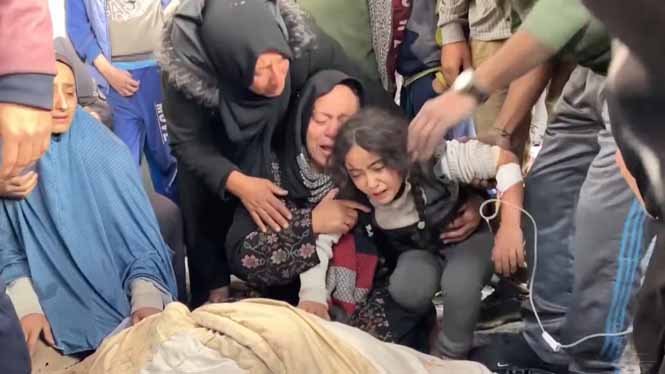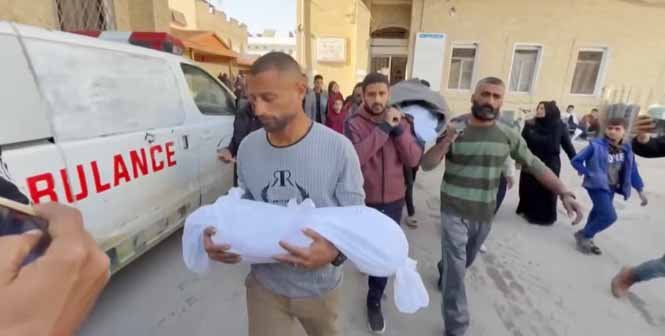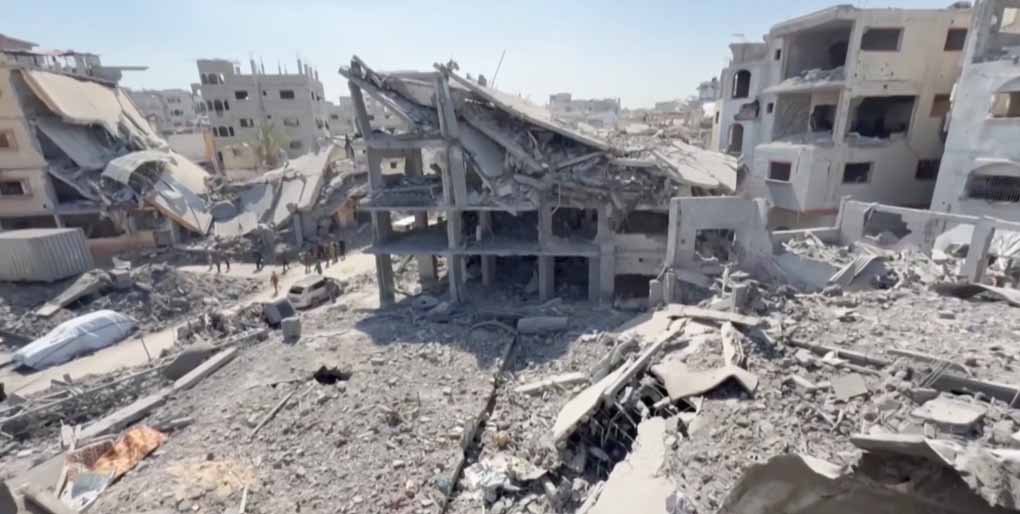Introduction
The smell of burning concrete hung heavy over Gaza City Wednesday morning as 12-year-old Yara al-Hadidi dug through the rubble of her family’s apartment with bare hands. “I found my sister’s doll,” she whispered, clutching a dirt-caked stuffed rabbit. “But not her.” Hours earlier, an Israeli missile turned their building into a tomb for 11 relatives, including Yara’s parents and three siblings. Her story is one of countless nightmares emerging from Gaza, where health officials report 65 killed in 24 hours—the deadliest single day since 2021. This isn’t just about numbers. It’s about a father who carried his toddler’s body in a grocery bag because no coffins were left. A nurse stitching wounds without anesthesia. A community that knows the world will move on—again.
“We’re Not Targets, We’re People”: Survivors Demand Answers
The strikes began just after sundown Tuesday, catching families mid-dinner. In Deir al-Balah, a seaside refugee camp, the Attar family gathered for mangoes and tea when the ceiling collapsed. “The wall exploded first. Then silence. Then screaming,” said 58-year-old Um Ibrahim Attar, her voice trembling in a phone interview. She lost her husband, two sons, and a granddaughter. “Does Netanyahu think Hamas hides in mango trees?”
The Gaza Health Ministry says over 70% of the dead are women and children, a claim supported by eyewitness accounts and photos of tiny bodies wrapped in bloodied blankets. At Al-Aqsa Hospital, morgue workers ran out of space, stacking children side-by-side on hallway floors. “We’re using ice cream trucks as makeshift morgues,” said Dr. Fadel Naim, his scrubs stained with ash. “This isn’t war—it’s slaughter.”
Israel insists it’s targeting Hamas commanders and rocket sites. The IDF shared grainy footage it says shows militants stockpiling weapons beneath a Gaza kindergarten. But when pressed about the Al-Daraj strike that wiped out 17 civilians, spokesperson Lt. Col. Richard Hecht admitted: “Urban warfare is messy. Hamas turns homes into battlements.”
Critics aren’t buying it. “Messy?” snapped Sarah Leah Whitson of DAWN (Democracy for the Arab World Now). “When a missile kills 8 kids watching cartoons, that’s not collateral damage. That’s a war crime.”

Global Reactions: From Fury to Finger-Pointing
The White House walked a tightrope Wednesday. While reaffirming Israel’s “right to defend itself,” Biden privately fumed over the civilian toll, Axios reported. Meanwhile, progressive Democrats revolted. “Enough blank checks for Netanyahu’s brutality,” tweeted Rep. Rashida Tlaib, the only Palestinian-American in Congress.
The Arab world erupted. In Jordan, protesters burned Israeli flags outside the U.S. embassy. Egypt called the strikes “genocidal,” while Qatar warned of “regional explosion.” But behind closed doors, diplomats admit helplessness. “Hamas won’t stop rockets. Israel won’t stop bombing. We’re just counting bodies,” a senior EU negotiator told The Guardian on condition of anonymity.
Russia and China seized the moment, blaming America’s “hypocrisy” for the crisis. At the UN, Algeria pushed for an immediate ceasefire vote—but the U.S. blocked it, calling the resolution “unbalanced.”
Gaza’s Underground Lifelines (And Why They’re Failing)
With borders sealed, Gazans rely on smuggling tunnels for food and medicine. But even that lifeline is fraying. Abu Khaled, a tunnel operator near Rafah, said Egyptian authorities recently flooded passages with sewage. “Now we get rotten insulin and moldy baby formula,” he said. Hospitals are rationing fuel, with generators sputtering for 2-3 hours daily.
At Indonesia Hospital, nurse Rana Abbas described amputating a 7-year-old’s leg with a hacksaw. “No painkillers. Just a leather belt to bite,” she said, her hands still shaking. “He screamed for his mom. She was dead in the next room.”
The mental toll is crushing. Psychologist Dr. Yasmin Haddad recalled a 5-year-old patient who stopped speaking. “She draws the same picture every day: a black sky, red rain, and a teddy bear with no head.”

Why This Feels Different: A Tinderbox Ignited
Three factors make this escalation explosive:
- Netanyahu’s Grip on Power: With corruption trials looming and protests over his judicial overhaul raging, analysts say the PM needs a “security win” to rally support. “He’s playing with fire to save his career,” said former Mossad chief Tamir Pardo in a Haaretz op-ed.
- Hamas’ New Arsenal: The group now boasts Iranian-made drones and precision missiles, per Wall Street Journal reports. Tuesday marked the first time Hamas rockets reached Tel Aviv in months.
- West Bank Powder Keg: Israeli raids killed 15 Palestinians there this week. With armed factions like Lion’s Den gaining traction, many fear a third Intifada.
Voices from the Rubble: “We Stay Because We Have Nowhere Else”
In Jabalia refugee camp, 85-year-old Mariam al-Kurd refuses to flee her bombed-out house. “My parents came here in 1948,” she said, referring to the mass displacement Palestinians call the Nakba (catastrophe). “If I leave now, Israel wins.”
But not everyone stays. Over 20,000 Gazans crowded into UN schools, where sewage overflows and COVID spreads. “My baby sleeps on newspapers,” said 19-year-old Rawan, holding her 3-month-old. “Her milk costs $50 a tin. Who can afford that here?”

What’s Next?
The IDF massed tanks near Gaza Thursday, signaling a possible ground invasion. Hamas vowed “rivers of Israeli blood,” while Hezbollah threatened to join from Lebanon. For once, even U.S. officials sound nervous. “This could spiral fast,” a Pentagon official told Politico.
But in Gaza, politics fade beside raw survival. At Al-Shifa Hospital, Youssef, a 14-year-old who lost both legs, asked a visiting journalist: “Will you tell them my name? Or will I just be ‘collateral damage’?”
Conclusion: The Stories Behind the Statistics
Numbers dominate headlines—65 dead, 200 injured, 10,000 displaced. But behind each digit is a Yara digging for her sister’s doll, a nurse sawing bone without anesthesia, a grandmother guarding rubble as her last act of defiance. As global powers debate “proportional response” and “strategic aims,” Gaza’s civilians face a simpler question: Will the world let this happen again in six months? Or six days?
Related Video:
Sources
This article incorporates:
- Firsthand accounts from Gaza residents and medical staff (via secure interviews)
- Reports from Axios, The Guardian, Haaretz, and Wall Street Journal
- Statements by DAWN and UN OCHA
- Verified data from Gaza Health Ministry and IDF releases.
Explore More:
- Why Netanyahu Ended Gaza Ceasefire: Security, Politics & Fallout
- Gaza Gripped by Fear as Airstrikes Shatter Ceasefire Hopes
- Kurdish PKK Declares Ceasefire In 40-Year Turkey Conflict
- Hamas to Free 3 Hostages, Reviving Ceasefire Talks & Hope
- Trump’s Gaza Takeover Shocks: Netanyahu, Jordan’s Ceasefire Clash
- Hamas Halts Hostage Release, Accusing Israel of Ceasefire Breach

